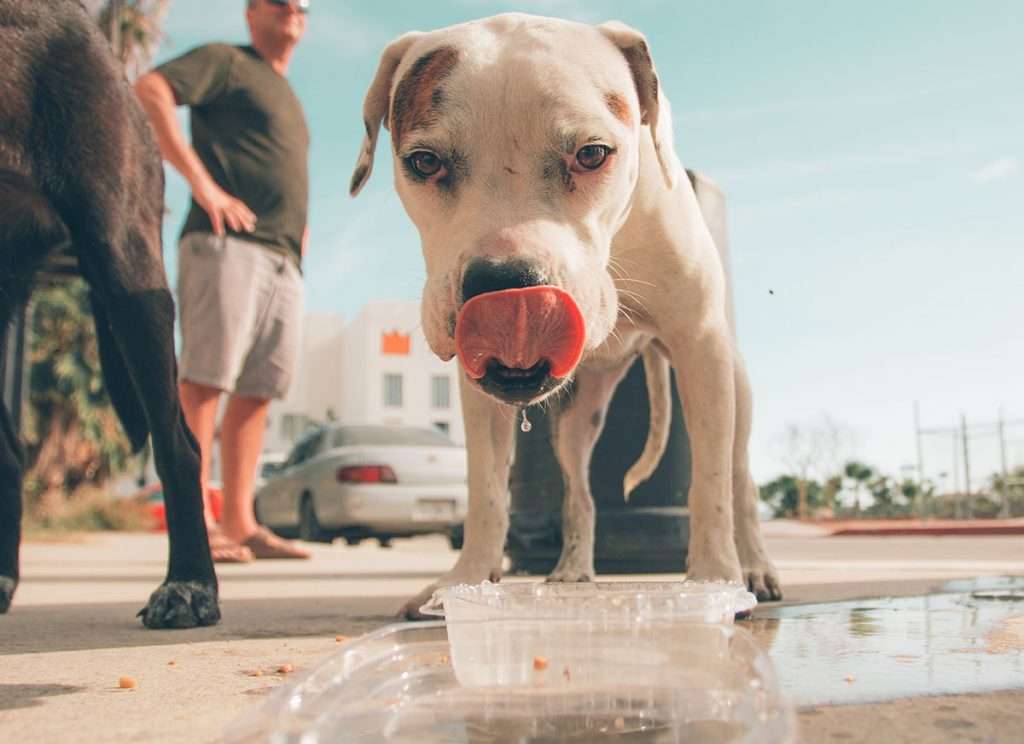
Eye Infections in Dogs: Definitive Guide & Expert Solutions
-
 By
Alexander Thornton
By
Alexander Thornton
- Last updated: November 5, 2023

Our canine companions rely heavily on their keen sense of sight to navigate their world and communicate with us. However, just like humans, dogs are susceptible to various eye infections and conditions that can compromise their vision and overall well-being.
Understanding the reasons behind the urgency of addressing these issues ensures that our furry friends receive the care they need to maintain optimal eye health and lead happy, healthy lives.
In this article, we will explore the common types of dog eye infections, their symptoms, and the essential steps to ensure your furry friend’s eye health and
overall well-being.
Table of Contents
Types of Eye Infections in Dogs

Conjunctivitis (Pink Eye)
Conjunctivitis in dogs is an eye condition characterized by inflammation of the conjunctiva, which is the thin, transparent membrane that covers the eyeball and lines the eyelids.
Symptoms of Conjunctivitis in Dogs
Conjunctivitis in dogs typically manifests with the following symptoms:
- Redness and inflammation of the conjunctiva
- Swelling around the eye
- Excessive tearing or discharge
- Squinting or frequent blinking
- Increased sensitivity to light (photophobia)
- Cloudiness in the affected eye
Dogs Prone to Conjunctivitis
Certain dog breeds may have a higher predisposition to developing conjunctivitis, but it’s important to remember that this condition can occur in dogs of any breed. These breeds include but are not limited to:
- Bulldogs
- Shih Tzus
- Cocker Spaniels
- Pugs
Causes of Conjunctivitis in Dogs
Several factors can lead to conjunctivitis in dogs, including:
- Allergies to pollen, dust, or other irritants
- Exposure to smoke, chemicals, or foreign objects
- Bacterial or viral infections
- Underlying health conditions, such as dry eye (keratoconjunctivitis sicca)
- Trauma or injury to the eye
Treatment of Conjunctivitis in Dogs
Treatment for conjunctivitis depends on its underlying cause and may involve:
- Topical antibiotic or antiviral eye drops or ointments
- Cleaning the eye with a sterile saline solution
- Identifying and addressing any allergens or irritants
- Treating underlying health issues contributing to the condition
- In severe or chronic cases, additional tests and treatments may be necessary
Urgency of Conjunctivitis in Dogs
While conjunctivitis in dogs is typically not life-threatening, it should be addressed promptly to alleviate discomfort and prevent potential complications.
Delaying treatment can lead to more significant eye problems, so if you observe any signs of conjunctivitis in your dog, seeking veterinary care is essential to determine the cause and receive appropriate treatment.

Keratitis
What is Keratitis in Dogs?
Symptoms of Keratitis in Dogs
- Excessive tearing or discharge
- Squinting or frequent blinking
- Redness and inflammation of the eye
- Sensitivity to light (photophobia)
- Pawing at the affected eye
- Cloudiness or opacity of the cornea
- Impaired vision or vision loss
Dogs Prone to Keratitis
Keratitis in dogs can affect various breeds, but some breeds may have a higher predisposition to this condition due to their unique eye anatomy or genetic factors. Some dog breeds that are occasionally reported to be more prone to keratitis include:
- Bulldogs
- Pugs
- Shih Tzus
- Lhasa Apsos
Causes of Keratitis in Dogs
Several factors can lead to keratitis in dogs, including:
- Foreign objects or debris irritating the eye
- Trauma or injury to the cornea
- Infections, both bacterial and viral
- Allergies or immune-mediated diseases
- Dry eye (keratoconjunctivitis sicca)
- Certain breeds may be predisposed to developing keratitis
Treatment of Keratitis in Dogs
Treatment for keratitis in dogs depends on the underlying cause and the severity of the condition. Common treatment approaches may include:
- Topical antibiotic or antiviral eye drops or ointments to combat infections
- Lubricating eye drops or artificial tears to alleviate discomfort
- Anti-inflammatory medications to reduce swelling and pain
- Identifying and addressing any underlying factors, such as allergies or autoimmune conditions
- In severe cases, surgical interventions may be necessary to repair corneal damage or address chronic issues.
Urgency of Keratitis in Dogs
Keratitis in dogs requires prompt veterinary attention due to the potential for vision impairment and pain associated with the condition. Delaying treatment can lead to further corneal damage, vision loss, and complications.
If you notice any signs of keratitis in your dog, such as redness, squinting, or excessive tearing, it’s crucial to seek immediate veterinary care to determine the cause and initiate appropriate treatment to protect your furry friend’s eye health.

Blepharitis
What is Blepharitis in Dogs?
Symptoms of Blepharitis in Dogs
Blepharitis in dogs often presents with the following symptoms:
- Redness and swelling of the eyelid margins
- Excessive tearing or discharge
- Crusting or matting of the eyelashes
- Rubbing or pawing at the affected eyes
- Sensitivity to light (photophobia)
- Development of small pimples or pustules along the eyelid margins
Dogs Prone to Blepharitis
Certain dog breeds may be more prone to developing blepharitis due to their conformation or genetic predisposition. These breeds include but are not limited to:
- Bulldogs
- Pugs
- Shih Tzus
- Lhasa Apsos
- Cocker Spaniels
Causes of Blepharitis in Dogs
Several factors can contribute to blepharitis in dogs, including:
- Bacterial infections of the eyelid glands
- Allergies to environmental irritants or food
- Parasitic infestations, such as mites
- Immune system disorders
- Hormonal imbalances
- Anatomical abnormalities or conformational issues
Treatment of Blepharitis in Dogs
Treating blepharitis in dogs involves addressing its underlying cause and alleviating discomfort. Common treatment approaches may include:
- Topical antibiotic or anti-inflammatory eye ointments or drops
- Warm compresses to soften crusts and promote healing
- Cleaning the affected area to remove debris and discharge
- Identifying and managing any underlying allergies or infections
- In severe or chronic cases, surgical procedures may be necessary to address eyelid abnormalities.

Cherry Eye (Nictitans Gland Prolapse)
What is Cherry Eye in Dogs?
Cherry Eye, formally known as Nictitans Gland Prolapse, is a common eye condition in dogs characterized by the prolapse or displacement of the third eyelid’s gland. This condition can lead to discomfort for your furry companion and, if left untreated, may result in eye problems.
Symptoms of Cherry Eye in Dogs
Cherry Eye in dogs often presents with the following symptoms:
- A visible red or pink mass in the corner of the eye (resembling a cherry)
- Excessive tearing or discharge
- Squinting or frequent blinking
- Rubbing or pawing at the affected eye
- Irritation and discomfort
- Conjunctivitis (inflammation of the conjunctiva)
Dogs Prone to Cherry Eye
While Cherry Eye can affect any dog breed, certain breeds may be more predisposed to this condition. These breeds include but are not limited to:
- Bulldogs
- Beagles
- Cocker Spaniels
- Lhasa Apsos
- Shih Tzus
Causes of Cherry Eye in Dogs
The exact cause of Cherry Eye is not always clear, but it can be influenced by factors such as genetics, weak connective tissue, or underlying inflammation. It may also be associated with trauma or injury to the eye area.
Treatment of Cherry Eye in Dogs
Treating Cherry Eye in dogs may involve various approaches depending on the severity of the condition. In mild cases or during the initial stages, your veterinarian may attempt non-surgical treatments, such as gentle massage or the use of anti-inflammatory medications to reduce swelling and promote gland repositioning.
Anti-inflammatories that are commonly prescribed by vets for Cherry Eye include meloxicam, carprofen, or flunixin meglumine. These medications can help reduce swelling and inflammation in the affected eye, potentially aiding in the repositioning of the prolapsed gland in mild cases of Cherry Eye. The specific medication and dosage should be determined by a veterinarian based on your dog’s condition and individual needs. It’s essential to follow your vet’s guidance and prescriptions for the safe and effective treatment of Cherry Eye.
However, if non-surgical methods prove ineffective, or if Cherry Eye is in an advanced state, surgical correction becomes necessary. Surgery typically involves repositioning the prolapsed gland and securing it in place. Common surgical techniques include the “tucking” method, where the gland is sutured back into its normal position, and the complete gland removal, which is considered in more severe or recurrent cases.
Your veterinarian will carefully assess your dog’s specific condition and recommend the most appropriate surgical approach to address Cherry Eye effectively while minimizing discomfort and preserving eye health.
Urgency of Cherry Eye in Dogs
Seeking prompt veterinary care for Cherry Eye is crucial to prevent complications, as untreated cases can lead to chronic discomfort, eye irritation, and potentially more severe eye problems. If you notice any signs of Cherry Eye in your dog, such as a pink or red mass in the eye corner, tearing, or irritation, consult your veterinarian promptly to determine the best course of action to preserve your dog’s eye health.

Corneal Ulcers
What are Corneal Ulcers in Dogs?
Corneal ulcers in dogs are open sores or injuries that occur on the cornea, the clear, protective outermost layer of the eye.
Symptoms of Corneal Ulcers in Dogs
Corneal ulcers in dogs often present with the following symptoms:
- Excessive tearing or eye discharge
- Squinting or frequent blinking
- Redness and inflammation of the eye
- Pawing at the affected eye
- Sensitivity to light (photophobia)
- Cloudiness or opacity of the cornea
- Impaired vision or vision loss
Dogs Prone to Corneal Ulcers
While corneal ulcers can affect any dog, certain factors may make some dogs more prone to developing them.
Breeds with prominent eyes, such as Pugs, Bulldogs, Boston Terriers, and Boxers, may be at a higher risk due to their eye anatomy.
Additionally, dogs with a history of chronic dry eye (keratoconjunctivitis sicca) or entropion (inward-rolling eyelids) may also have an increased susceptibility to corneal ulcers.
Causes of Corneal Ulcers in Dogs
Several factors can lead to corneal ulcers in dogs, including:
- Trauma or injury to the eye, such as scratches or foreign objects
- Infections, both bacterial and fungal
- Dry eye (keratoconjunctivitis sicca)
- Entropion or eyelid abnormalities
- Tear film disorders
- Exposure to irritants or chemicals
Treatment of Corneal Ulcers in Dogs
Treating corneal ulcers in dogs involves addressing their underlying cause and promoting corneal healing. Common treatment approaches may include:
- Topical antibiotic or antifungal eye drops or ointments to combat infections
- Pain relief medications to alleviate discomfort
- Use of a protective collar (Elizabethan collar) to prevent further trauma
- Nutritional supplements or medications to stimulate tear production
- In severe cases or if nonsurgical treatments fail, surgical intervention may be necessary, such as corneal grafts or conjunctival flap procedures.
Urgency of Corneal Ulcers in Dogs
Seeking prompt veterinary care for corneal ulcers is essential to prevent complications such as corneal perforation, scarring, and vision loss. Delaying treatment can lead to more significant eye problems and discomfort for your dog.
If you observe any signs of corneal ulcers in your dog, such as eye redness, squinting, or excessive tearing, consult your veterinarian immediately to determine the cause and initiate the appropriate treatment to safeguard your dog’s eye health.

Uveitis
What is Uveitis in Dogs?
Uveitis in dogs is a condition characterized by inflammation of the uvea, the middle layer of the eye. This layer includes the iris (colored part of the eye), ciliary body (responsible for producing eye fluid), and choroid (providing blood supply to the eye).
Symptoms of Uveitis in Dogs
Uveitis in dogs often presents with the following symptoms:
- Redness and inflammation of the eye
- Squinting or frequent blinking
- Watery or cloudy eye discharge
- Sensitivity to light (photophobia)
- Changes in the color or appearance of the iris
- Swelling or enlargement of the eye
- Vision changes or vision loss
Dogs Prone to Uveitis
Uveitis can affect dogs of all breeds and ages. However, certain underlying conditions or predispositions may increase the risk of uveitis. These include autoimmune disorders, infectious diseases, or previous eye injuries.
Some breeds, such as Siberian Huskies and Collies, may also have a genetic predisposition to certain types of uveitis.
Causes of Uveitis in Dogs
Several factors can lead to uveitis in dogs, including:
- Infections, such as bacterial, viral, or fungal
- Autoimmune diseases, where the dog’s immune system mistakenly attacks the eye
- Trauma or injury to the eye
- Tumors or cancers
- Systemic diseases, such as tickborne illnesses
- Exposure to toxins or allergens
Treatment of Uveitis in Dogs
Treating uveitis in dogs involves addressing its underlying cause, reducing inflammation, and managing symptoms. Common treatment approaches may include:
- Topical or systemic anti-inflammatory medications to control inflammation
- Antibiotics or anti-viral medications if an infection is the cause
- Pain relief medications to alleviate discomfort
- Identifying and addressing any underlying systemic diseases or conditions
- In severe cases or when vision is severely compromised, more advanced treatments, including surgery or laser therapy, may be considered.
Urgency of Uveitis in Dogs
Seeking prompt veterinary care for uveitis in dogs is crucial to prevent complications such as glaucoma, cataracts, and vision loss. Delaying treatment can lead to more significant eye problems and discomfort for your dog.
If you observe any signs of uveitis in your dog, such as eye redness, squinting, or changes in eye appearance, consult your veterinarian immediately to determine the cause and initiate the appropriate treatment to safeguard your dog’s eye health.

Glaucoma
What is Glaucoma in Dogs?
Glaucoma in dogs is a condition characterized by increased pressure within the eye due to impaired drainage of aqueous humor, the fluid that nourishes and maintains the eye’s shape. Elevated intraocular pressure can lead to optic nerve damage, vision loss, and discomfort for your furry companion.
Symptoms of Glaucoma in Dogs
Glaucoma in dogs often presents with the following symptoms:
- Redness and inflammation of the eye
- Squinting or frequent blinking
- Cloudiness or bluing of the cornea
- Enlargement or bulging of the affected eye
- Excessive tearing or eye discharge
- Behavioral changes, such as increased agitation or restlessness
- Vision changes or vision loss
Dogs Prone to Glaucoma
While glaucoma can affect dogs of any breed, certain breeds may have a higher predisposition due to their anatomy.
Breeds such as Cocker Spaniels, Basset Hounds, and Shih Tzus are more prone to primary glaucoma, a hereditary form of the condition. Secondary glaucoma can occur in any breed as a result of other eye diseases or conditions.
Causes of Glaucoma in Dogs
Glaucoma in dogs can result from various factors, including:
- Primary glaucoma, which is often hereditary and related to anatomical factors
- Secondary glaucoma, caused by other eye diseases or conditions
- Trauma or injury to the eye
- Tumors or cancers affecting the eye
- Inflammation or uveitis
- Lens luxation, where the eye’s lens shifts out of its normal position
Treatment of Glaucoma in Dogs
Treating glaucoma in dogs aims to reduce intraocular pressure, alleviate discomfort, and preserve vision when possible. Common treatment approaches may include:
- Topical or systemic medications to lower intraocular pressure
- Pain relief medications to manage discomfort
- Surgical interventions, such as laser therapy or drainage implant procedures
- Identifying and addressing underlying causes or contributing factors
- In severe cases where vision cannot be preserved, surgical removal of the affected eye (enucleation) may be necessary
Urgency of Glaucoma in Dogs
Seeking prompt veterinary care for glaucoma in dogs is crucial to prevent irreversible vision loss and relieve pain. Glaucoma is considered an emergency, and delaying treatment can result in permanent damage to the optic nerve and blindness.
If you observe any signs of glaucoma in your dog, such as eye redness, cloudiness, or behavioral changes, consult your veterinarian immediately to determine the cause and initiate the appropriate treatment to safeguard your dog’s eye health.

Dry Eye (Keratoconjunctivitis Sicca)
What is Dry Eye in Dogs?
Dry Eye, medically known as Keratoconjunctivitis Sicca (KCS), is a common eye condition in dogs characterized by a deficiency in tear production. This deficiency results in insufficient lubrication and moisture on the surface of the eye, leading to discomfort, inflammation, and potential complications.
Symptoms of Dry Eye in Dogs
Dry Eye in dogs often presents with the following symptoms:
- Excessive blinking or squinting
- Redness and inflammation of the eye
- Thick, yellow or green eye discharge
- Pawing at or rubbing the affected eye
- Sensitivity to light (photophobia)
- Cloudiness or opacity of the cornea
- Changes in eye appearance or discomfort
Dogs Prone to Dry Eye
While Dry Eye can affect dogs of any breed, certain breeds may have a higher predisposition due to genetics. Breeds such as Bulldogs, Shih Tzus, Cocker Spaniels, and West Highland White Terriers are more commonly affected by Dry Eye.
Causes of Dry Eye in Dogs
Dry Eye in dogs can result from various factors, including:
- Autoimmune diseases that damage the tearproducing glands
- Medications that suppress tear production as a side effect
- Certain infections affecting the eye
- Trauma or injury to the eye
- Aging, as tear production may decrease with age
Treatment of Dry Eye in Dogs
Treating Dry Eye in dogs involves addressing the underlying cause, increasing tear production, and managing symptoms. Common treatment approaches may include:
- Prescription medications, such as cyclosporine or tacrolimus, to stimulate tear production
- Lubricating eye drops or ointments to provide moisture and relief
- Antibiotics if secondary infections are present
- Identifying and managing underlying autoimmune conditions
- In severe cases, surgical procedures may be considered to address the underlying cause
Urgency of Dry Eye in Dogs
Seeking prompt veterinary care for Dry Eye in dogs is crucial to prevent complications such as corneal ulcers, scarring, and vision loss. Untreated Dry Eye can cause chronic discomfort and potential longterm damage to the eye’s surface.
If you observe any signs of Dry Eye in your dog, such as eye redness, excessive discharge, or discomfort, consult your veterinarian immediately to determine the cause and initiate the appropriate treatment to safeguard your dog’s eye health.

Home Remedies for Eye Infections in Dogs
The effectiveness and safety of home remedies for dog eye conditions can vary depending on the specific condition and the individual dog.
While these remedies may provide relief for mild eye irritations, they should never replace professional veterinary care. Here are some home remedies that may help alleviate mild eye irritation, but should only be used under veterinary guidance:
Warm Compresses (After Veterinary Recommendation):
- Applicable for mild irritations and some minor infections.
- May not be suitable for more serious conditions like glaucoma, where increased eye pressure is a concern
Gently applying a warm, damp washcloth or cotton ball to your dog’s closed eyes can help soothe mild eye irritation and reduce crusting or discharge. Always consult your veterinarian before attempting this.
Saline Solution Rinse (Under Veterinary Guidance):
- Can be used to flush out irritants and debris in mild cases.
- May not address underlying causes of more severe conditions and should not be used as the sole treatment
A homemade saline solution, made by mixing one teaspoon of salt with one cup of distilled water, can be used to rinse your dog’s eyes. Use a clean, lintfree cloth or a sterile eye dropper to apply the solution. This can help flush out irritants and debris, but only use it as recommended by your vet.
Artificial Tears or Lubricating Eye Drops (Upon Veterinary Advice):
- Effective for providing temporary relief from dryness in mild cases
- Not a treatment for the underlying causes of conditions like glaucoma or uveitis and should be used under veterinary guidance
Artificial tears or lubricating eye drops made specifically for dogs can provide temporary relief from dryness and minor irritation. Be sure to choose products recommended by your veterinarian and use them as directed.
Avoid Irritants (As Per Vet’s Instructions):
- Beneficial for preventing further irritation and allergies
- May not provide direct relief for existing eye conditions and should be used in conjunction with other treatments
Ensure your dog’s environment is free from potential irritants, such as cigarette smoke, strong cleaning chemicals, or airborne allergens. Reduce exposure to these irritants only as advised by your veterinarian.
Gently Remove Discharge (Only Under Veterinary Guidance):
- Can help manage mild discharge and prevent crust formation
- Must be done with caution to avoid further irritation, especially in cases of severe conjunctivitis or corneal ulcers
If your dog has eye discharge or crust, you can carefully and gently clean it away with a moist, soft cloth. Avoid using harsh chemicals or excessive force, and perform this action only if recommended by your veterinarian.
Remember: these home remedies should be viewed as complementary measures to professional veterinary care.
If your dog’s eye condition persists, worsens, or is associated with severe symptoms such as pain, redness, swelling, or changes in vision, consult your veterinarian promptly.
Serious eye conditions require timely diagnosis and treatment by a qualified veterinarian to prevent complications and preserve your dog’s eye health.
The Importance of Seeking Veterinary Advice
Veterinary care for eye infections in dogs is of utmost importance. A trained veterinarian’s prompt and accurate diagnosis is essential to identify the underlying cause, whether it’s conjunctivitis, keratitis, or any other condition.
This professional care ensures that tailored treatment plans are in place, addressing not just symptoms but also the root cause.
Delaying or neglecting professional care can lead to the progression of the infection, causing pain, vision loss, and potential complications that could have been prevented.
Moreover, some eye infections in dogs may be contagious to other dogs or even humans, underscoring the importance of timely veterinary intervention to safeguard the wellbeing of both your pet and your family.
Routine eye exams and diligent followup care also play a crucial role in maintaining your dog’s eye health, making veterinary care an integral part of responsible pet ownership.
why are Eye Symptoms Time Sensitive Issues?
Eye symptoms in dogs are among the most time sensitive issues because they often signify underlying problems that can rapidly worsen without timely intervention. Dogs heavily rely on their vision, and any compromise to their eyes can cause immediate discomfort and distress.
Unlike some health concerns that may develop slowly over time, eye infections and conditions can escalate quickly, potentially leading to severe consequences such as permanent vision loss or even the loss of the affected eye itself.
Additionally, because dogs may not always show overt signs of pain or discomfort, it’s crucial to recognize and address eye symptoms promptly to prevent your pet from silently suffering.
Given the delicate nature of the eye and its critical role in a dog’s life, early veterinary care is imperative to ensure the best possible outcome and preserve your furry companion’s quality of life.
Utilizing 24/7 Online Vet Services
As dog enthusiasts, we understand the importance of reliable and accessible veterinary care.
Online veterinary services go beyond mere convenience; connecting you with licensed veterinarians where and when you need it, offering peace of mind to pet parents worldwide, which makes it a reliable choice for your furry family members.

Vetster
Vetster, our tried and true favorite online veterinary service has truly become a trusted companion in pet care, always just a click away.
With our own firsthand experience, we’ve come to rely on Vetster’s expertise and convenience whenever our furry friends need assistance. Vetster’s cost effective advantage lies in its ability to provide advice on whether an in-person vet visit is necessary, helping pet owners save money by avoiding unnecessary trips to the clinic.
It’s like having a knowledgeable friend in the pet care world, available whenever you need them, and that peace of mind is truly priceless. Here are some of the benefits and reasons why we’re big fans of Vetster:
- Immediate Access to Trusted Vets from Any Location
Vetster breaks down geographical barriers, allowing pet owners to connect with experienced veterinarians from anywhere. Whether you’re at home, traveling, or in a remote area, you can rest assured that professional veterinary advice is just a click away. This immediate access ensures that your pet receives timely care and guidance when they need it most.
- Vet Access 24/7
Emergencies don’t always happen during regular clinic hours, and that’s where Vetster shines. With 24/7 availability, you can reach out to veterinarians at any time, providing peace of mind knowing that help is readily available, even in the middle of the night or on weekends. Vetster ensures that your pet’s health is a priority, no matter the hour.
- Stress Free Vet Care
Traditional vet visits can be stressful for pets, with unfamiliar surroundings, other animals, and the overall clinic experience. Vetster’s online consultations occur in the comfort of your pet’s home, eliminating these stressors. This reduced stress not only makes the experience more comfortable for your pet but also contributes to more accurate assessments and a smoother consultation.
- Ongoing Support
Vetster isn’t limited to a onetime consultation. Pet owners can schedule followup appointments as needed, ensuring that your pet’s health is continuously monitored. This ongoing support is invaluable when managing chronic conditions or tracking the progress of treatments, providing comprehensive care for your furry friend.
- Cost Effective
Vetster offers cost efficient initial assessments, which can help you avoid unnecessary expenses. By starting with an online consultation, you can determine whether an inperson visit is immediately necessary. This costeffective approach empowers pet owners to make informed decisions about their pets’ health while managing their budget effectively.
- Ease of Use with the Vetster App
Accessing Vetster’s services couldn’t be simpler, thanks to the userfriendly Vetster app. It’s designed to make the entire process seamless, from scheduling appointments to connecting with veterinarians. The app puts the power of expert veterinary advice in the palm of your hand, making it incredibly convenient to seek guidance and care for your pet at any time
It is important to consider the potential complications that can arise when pet owners don’t seek professional advice for their dogs’ eye symptoms. Ignoring or delaying veterinary care can lead to serious issues and compromises your pet’s wellbeing.

Potential Complications
Eye infections pose significant threats to your dog’s health and overall wellbeing. To safeguard your pet from more severe issues, primary prevention is paramount.
Neglecting or improperly treating these infections can lead to a host of serious risks, including the spread of infection, visual impairment, persistent pain, subsequent health complications, recurring infections, corneal ulcers, a weakened immune system, and increased treatment expenses.
Therefore, seeking professional advice and early treatment is crucial in mitigating the potential dangers associated with untreated or inadequately managed dog eye infections. Your pet’s health and happiness depend on it.
Cost Implications
The costs associated with treating eye infections in dogs can vary widely depending on the severity of the condition and the necessary treatments. On the lower end, basic treatments such as antibiotic eye drops may range from $20 to $50. However, more complex cases that require specialized diagnostics, surgical procedures, or longterm medications can cost significantly more, potentially ranging from $500 to $2,000 or even higher.
These estimates are approximate and can vary based on factors such as the specific treatment plan, the veterinarian’s fees, and geographical location.
It’s crucial for pet owners to be financially prepared for potential expenses and to prioritize early intervention and professional advice to manage costs effectively while ensuring the health and wellbeing of their dogs.

Home Care Tips for Eye Infections in Dogs
Home care for a dog with an eye infection can help alleviate discomfort and support the healing process. However, it’s essential to always follow any specific guidance given by your veterinarian, as it is tailored to your dog’s specific condition.
- Keep the Affected Area Clean: Gently clean the area around your dog’s infected eye with a damp, clean cloth or a saline solution recommended by your vet. Avoid touching the eye directly to prevent further irritation.
- Administer Medications: Follow your veterinarian’s instructions for administering any prescribed eye drops or ointments. Ensure you apply them as directed, and wash your hands before and after handling medication.
- Prevent Scratching: Use an Elizabethan collar (cone) to prevent your dog from scratching or rubbing their infected eye, which can worsen the condition.
- Maintain Good Hygiene: Keep your dog’s face and eye area clean and dry. Be cautious not to introduce dirt or debris into the infected eye.
- Provide a Calm Environment: Reduce stress and environmental irritants that can exacerbate the condition. Create a calm and comfortable space for your dog to relax.
- Monitor for Changes: Keep a close eye on your dog’s condition. If you notice any worsening of symptoms, such as increased redness, swelling, or discharge, or if your dog appears to be in pain, contact your vet promptly.
- Maintain Regular Veterinary Checkups: Continue to follow up with your vet as scheduled to monitor the progress of the infection and adjust the treatment plan as needed.
- Prevent Spread: Wash your hands thoroughly after handling your dog’s infected eye or applying medication to prevent the potential spread of infection.
Remember that every dog’s condition is unique, and home care should complement professional veterinary treatment. Consult your vet for a personalized care plan to ensure the best outcome for your furry friend.
Final Thoughts
Understanding and addressing eye infections in dogs are paramount for maintaining the health and happiness of our beloved fourlegged companions. Whether it’s conjunctivitis, keratitis, blepharitis, or other eye conditions, early detection and prompt veterinary care are essential. These conditions can lead to severe complications, including vision loss, if neglected or improperly treated.
We’ve explored the benefits of online veterinary services like Vetster, which offer immediate access to trusted veterinarians, reduce stress for dogs, and provide ongoing support, all while being cost-effective and user-friendly. These services have truly become invaluable resources, offering peace of mind to pet owners.
However, it’s crucial to remember that online consultations should complement, not replace, traditional veterinary care, especially when hands-on examinations and diagnostics are necessary. The significance of professional veterinary care cannot be overstated.
In the realm of dog eye infections, early intervention, regular checkups, and responsible pet ownership are key to preventing complications and ensuring the wellbeing of our furry family members. By staying informed, seeking timely advice, and prioritizing our dogs’ eye health, we can help them live happy, healthy lives with clear and bright eyes.

Frequently Asked Questions (FAQ)
Can a dog eye infection heal on its own?
Mild dog eye infections may occasionally improve without treatment, but it’s important to note that they often persist or worsen over time. Consulting a vet for proper diagnosis and treatment is typically the safest course of action.
When should I worry about my dog's eye infection?
Pay attention to your dog’s eye infection if you notice increased redness, swelling, discharge changes, squinting or pawing, vision issues, behavioral changes, or signs of a corneal ulcer. In such cases, consult a vet promptly for early intervention and your dog’s wellbeing.
Can I use human eye drops on my dog?
Avoid using human eye drops on your dog. Consult a vet for appropriate treatment tailored to your dog’s specific eye condition.
Will Benadryl help my dog’s eye infection?
Benadryl, an antihistamine, is primarily used to address allergic reactions and allergies in dogs. While it may provide relief for symptoms like itching or mild swelling associated with allergies, it does not treat the underlying cause of an eye infection.

Alexander Thornton
Latest From Our Blog

































